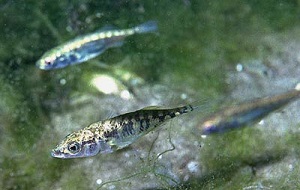
Humans have inhabited the Earth for millions of years, but how did we gain the ability to stand on two feet? Many would think the answer to “human bipedalism” – our ability to walk and stand on two feet – lies in the study of feet. Shockingly, however, recent research actually suggests that the trait may connect back to a tiny fish known as the threespine stickleback.
In early 2016, biologist at Stanford University David Kingsley and his team of researchers analyzed DNA of the threespine stickleback. They found a genetic enhancer coded within the fishes' DNA that helps to make the bony plates that scale the stickleback. This enhancer regulates the amount of GDF6, a bone-related protein, that is released in the body of the fish based on its environment.
For example, ocean sticklebacks that live in environments densely populated with predators tend to have a stronger build to their plates. In these situations, the enhancer allows for a higher production of the bone-boosting protein, which in turn gives these fish thick plates for protection.
For freshwater stickleback, on the other hand, there are fewer predators but still a high need to stay hidden in the waters. In this environment, the enhancer provides just enough GDF6 for the fish to end up with a slimmer and more flexible plate arrangement – perfect for accessing aquatic hiding places.
When researchers analyzed the role of GDF6 in the formation of bones in mammals, such as chimpanzees, they found that the enhancer for the protein only impacted the development of rear limbs. Its biggest effect was on the length and curvature of toes. However, it was also discovered that the gene for this enhancer was not present in human DNA.
This singular genetic change may explain, researchers indicate, why the feet of apes and humans are so different and – ultimately – how our ancestors became bipeds. A chimpanzee’s toes are long, curvy, and widely spread for easier climbing. In contrast, human feet have larger soles and a thicker big toe that aligns with the four other toes: this allows for a strong base that can support the weight of vertical locomotion.
The study of GDF6 in DNA shows the impact of small genetic changes on the evolution of organisms. Although researchers believe that the deletion of this bone-related enhancer isn’t the complete answer to how humans gained the ability to stand, it provides a huge insight into our evolutionary history. From these studies, it is clear that we share a nuanced history with the diverse living forms around us.
[Source:
Smithsonian Magazine
]

